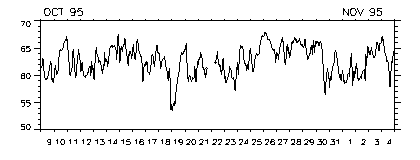
The Midnight Boundary Index is an estimate of the equatorward boundary of precipitating auroral electrons as determined by the SSJ4 instrument on DMSP spacecraft. Midnight Boundary data are available upon request. If the data are used in scientific studies, they should be referred to as "The Air Force Research Laboratory Auroral Boundary Index" and acknowledged as being provided by the USAF Research Laboratory, Kirtland AFB, NM. These data are in the public domain and no further permission is required. Please send a courtesy copy of any publications using the Boundary Index to K. Martin
This x-y plot shows Midnight Boundary variations during a 27 day period.

To see plots of recent values of the midnight boundary index, click on the items below. Files of the values plotted here and older values along with a "readme" file describing the files are available upon request.
Point of Contact: K. Martin
It has long been known that increased auroral activity, as indicated by many ionospheric and magnetospheric parameters such as brightness of auroral arcs, disturbances in the magnetic field, magnitude of the convection electric field and magnitude of field aligned currents, is accompanied by the expansion of the auroral oval.
A statistical study of the electron precipitation observed by SSJ4 instruments on DMSP spacecraft to Kp values was done by Gussenhoven et al. (1981). They determined the regression coefficients for a linear fit of equatorward auroral boundaries for 13 of the 24 hourly local time sectors and compared the results to the Kp indices. They identified equatorward auroral boundaries by hand, using precipitating electron measurements made onboard the DMSP/F2 satellite. A follow-on study (Gussenhoven et al., 1983) developed a computer algorithm for boundary selection and increased the database to 20 of 24 local time sectors by including data from DMSP F4. This work has continued to date with all available data from the SSJ4 instruments flown on DMSP spacecraft.
Although the auroral equatorward boundary, when drawn in geomagnetic coordinates, is nearly circular for all levels of auroral activity, its center is offset from the magnetic pole toward the post-midnight local time sector. The offset is a function of magnetic activity. Therefore, individual boundary measurements made for the same auroral activity, but at different local times will differ, and, as such, cannot be directly scaled to auroral activity without removing the local time variation. Removal of the local time variation is reasonably easy to accomplish by statistically determining the position of the auroral oval for every local time sector as a function of some magnetic activity index, such as Kp.
Go to DMSP Home Page